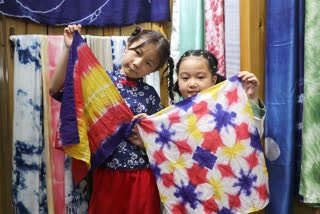
Students learn to tie-dye with the help of Yang Cheng.
Generations of people devote themselves to traditional tie-dye
Where do the colors of your clothes come from? The answer is dye. The clothes we wear these days are mainly dyed with chemicals in factories. But in the past, people did this by hand – and the dyes often came from plants.
With a history of more than 1,000 years, tie-dye is a very old way of dyeing clothes in China. It is most popular among the Bai ethnic group in Yunnan. During the Tang (618-907) and Song (960-1279) dynasties, people gave tie-dyed clothes to the emperor as gifts.
In 2006, the tie-dye technique was added to China’s national intangible cultural heritage list. Anning in Yunnan is known for tie-dye.
Master’s story
Yang Cheng, 52, is the inheritor of tie-dye in Anning, Yunnan. He learned the skill from his mother in the 1980s. And he has passed it down to his daughter.
“Tie-dye is worthy of the efforts of generations of people,” Yang said.
Yang has mastered all the old skills of tie-dye. To tie-dye, you first need to use threads to tie your cloth together. Then you put the cloth into the dye. As the cloth is folded and dyed, some parts become dark blue, while other parts have a lighter color. When you unfold the cloth, you’ll see beautiful patterns. “As for how to tie the cloth, there are more than 10 ways, let alone how you dye it,” Yang said. “So you’ll get all kinds of patterns.”
At the same time, Yang has studied tie-dye in other countries, such as Japan, India and France. He also tries to make some creative designs.
He once made two sets of tie-dyed wedding dresses. It took him two years! He used almost all the skills of An’ning tie-dye. Some patterns on the dresses are traditional such as small fish roes, while others are modern. He added elements of Dianchi Lake and eight popular flowers in Yunnan.
Now, Yang teaches tie-dye in schools, communities and companies. More than 100,000 people have learned from him, he said.
Some might worry that tie-dye will be replaced by machinery dyeing. But Yang is confident. “At the end of the day, machines can’t replace our creative hands,” Yang said.
Young voice
Ke Yishan, 13, Kunming, Yunnan
This summer, Yang Cheng taught me and other students how to tie-dye. He first showed us the hanfu, made of tie-dyed cloth. I was amazed by their colors and patterns! Then I tried tie-dye by myself. I tied a piece of white cloth into a knot. Then I made as many layersas possible so that the patterns might be more different. When I put the cloth into the blue dyes, the dyes soon swallowed it up. After that, I washed it with water and unfolded the cloth. It was like opening a mystery box to see the patterns!